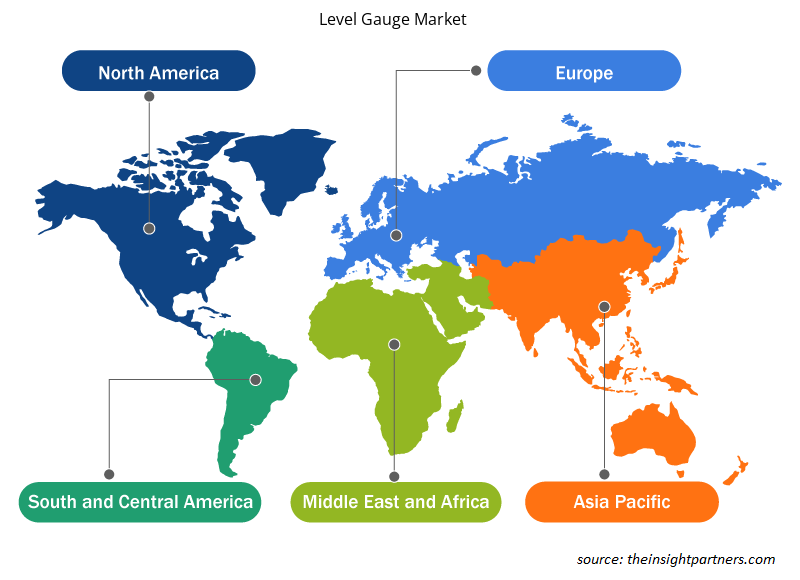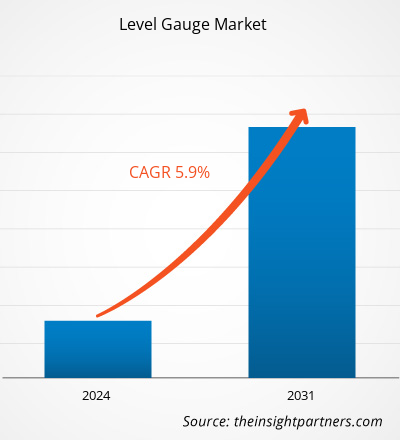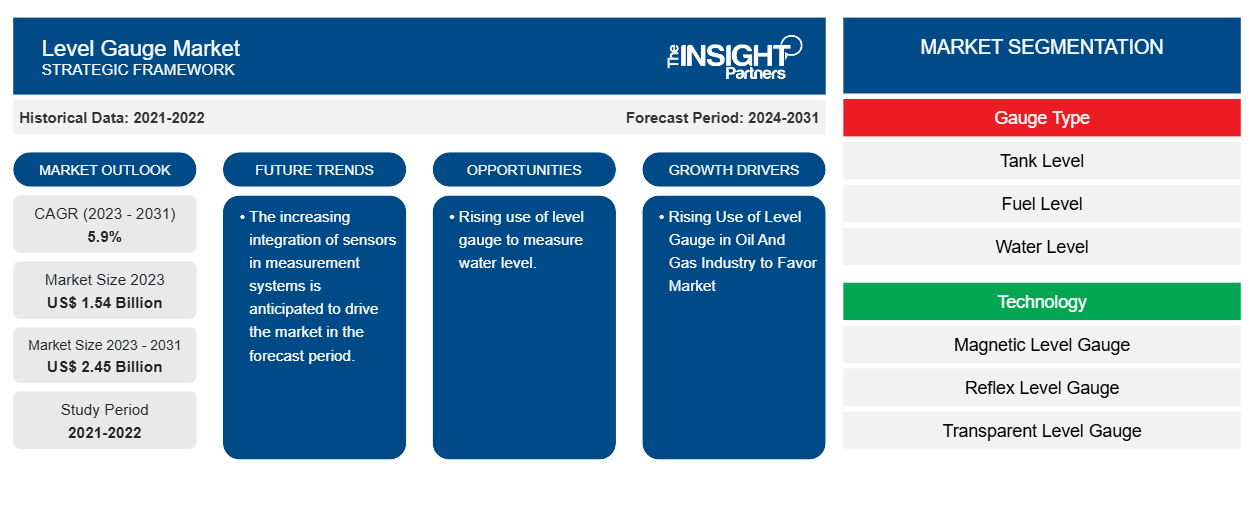Se proyecta que el tamaño del mercado de medidores de nivel alcance los 2.450 millones de dólares estadounidenses en 2031, frente a los 1.540 millones de dólares estadounidenses en 2023. Se espera que el mercado registre una CAGR del 5,90 % durante el período 2023-2031. Es probable que el uso cada vez mayor de medidores de nivel en la industria del petróleo y el gas y la creciente implementación de sistemas automáticos de medición de tanques sigan siendo tendencias clave y factores impulsores en el mercado.
Análisis del mercado de indicadores de nivel
El mercado de medidores está experimentando un crecimiento significativo a nivel mundial. Este crecimiento se atribuye aEl aumento del uso de medidores de nivel en la industria del petróleo y el gas y la creciente implementación de sistemas automáticos de medición de tanques. Además, se prevé que el aumento del uso de medidores de nivel para medir el nivel de agua y la integración de sensores en los sistemas de medición impulsarán el crecimiento del mercado en los próximos años.
Descripción general del mercado de indicadores de nivel
Los medidores de nivel son dispositivos de medición y detección que se utilizan para supervisar el nivel de un fluido en tanques u otros recipientes de almacenamiento. Estos instrumentos se utilizan con frecuencia en aplicaciones de procesos industriales para controlar los niveles de fluidos en tanques, tambores, recipientes a presión y otras aplicaciones similares. El medidor consta de numerosas piezas, entre ellas un cabezal, un flotador, una cinta métrica, un soporte anclado en la parte inferior, cables guía, codos, anclajes, acopladores, soportes de tuberías y tuberías.
Personalice este informe según sus necesidades
Obtendrá personalización en cualquier informe, sin cargo, incluidas partes de este informe o análisis a nivel de país, paquete de datos de Excel, así como también grandes ofertas y descuentos para empresas emergentes y universidades.
-
Obtenga las principales tendencias clave del mercado de este informe.Esta muestra GRATUITA incluirá análisis de datos, desde tendencias del mercado hasta estimaciones y pronósticos.
Impulsores y oportunidades del mercado de indicadores de nivel
El creciente uso de indicadores de nivel en la industria del petróleo y el gas favorece el mercado.
Los medidores de nivel de aceite se utilizan para controlar el nivel de llenado y detectar situaciones de funcionamiento. Permiten un control visual rápido y sencillo y también se pueden utilizar para otros medios junto con sistemas llenos de aceite o con un flujo de aceite. El reflector opcional hace que el nivel sea fácil de leer, incluso en condiciones de poca visibilidad. Además, los procesos de medición manual de tanques se pueden utilizar para tanques atmosféricos, que son adecuados para petróleo y productos petroquímicos que se pueden almacenar en condiciones ambientales. Los métodos tradicionales comprenden el uso de un medidor de nivel transparente y una cinta métrica para calcular el nivel de llenado. Por ejemplo, el método manual se puede utilizar para medir los niveles de petróleo crudo en un tanque cilíndrico de techo flotante con un medidor transparente incorporado. Esto aumenta la demanda y el uso de medidores de nivel en la industria del petróleo y el gas.
Aumento del uso del medidor de nivel para medir el nivel del agua.
Los medidores de nivel proporcionan una indicación visual rápida del nivel de agua en un canal, canal o vertedero. Aunque no se debe confiar únicamente en ellos cuando hay dispositivos de medición de nivel más precisos disponibles, los medidores de nivel permiten a los operadores medir rápidamente el nivel relativo del agua y luego continuar con otras tareas. Además, se están introduciendo en el mercado medidores electrónicos de nivel de agua. Es un nuevo tipo de sensor de medición de nivel de agua, que se compone de una placa de circuito impreso, un electrodo común, un electrodo de detección, resina epoxi , una carcasa de metal, cable, etc. Por lo tanto, considerando el alto requisito de medidores de nivel en la medición del nivel de agua, se anticipa que el mercado crecerá en los próximos años.mwasurement of water level, the market is anticipated to grow in coming years.
Análisis de segmentación del informe de mercado de medidores de nivel
Los segmentos clave que contribuyeron a la derivación del análisis del mercado de medidores de nivel son el tipo de medidor, la tecnología y el usuario final.
- Según el tipo de medidor, el mercado de medidores de nivel se divide en nivel de tanque, nivel de combustible, nivel de agua y nivel mecánico. Se prevé que el segmento de nivel de tanque tenga una participación de mercado significativa en el período de pronóstico.
- Según la tecnología, el mercado de medidores de nivel se divide en medidores de nivel magnéticos, medidores de nivel reflexivos, medidores de nivel transparentes, medidores de nivel tabulares y otros. Se prevé que el segmento de medidores de nivel magnéticos tenga una participación de mercado significativa en el período de pronóstico.
- Por usuario final, el mercado se segmenta en petróleo y gas, alimentos y bebidas, productos químicos y petroquímicos, marítimos, energía y electricidad, entre otros. Se prevé que el petróleo y el gas ocupen una cuota de mercado significativa en el período de pronóstico.
Análisis de la cuota de mercado de los indicadores de nivel por geografía
El alcance geográfico del informe de mercado de medidores de nivel se divide principalmente en cinco regiones: América del Norte, Asia Pacífico, Europa, Medio Oriente y África, y América del Sur y Central.
El mercado de medidores de nivel está dominado por América del Norte, que está segmentado en Estados Unidos, Canadá y México. El mercado está creciendo en la región y este crecimiento se atribuye al uso cada vez mayor de medidores de nivel en la industria del petróleo y el gas y al creciente despliegue de sistemas automáticos de medición de tanques. Además, el fuerte énfasis en la investigación y el desarrollo en las economías desarrolladas de Estados Unidos y Canadá está obligando a los actores norteamericanos a introducir soluciones tecnológicamente avanzadas en el mercado. Además, Estados Unidos cuenta con una gran cantidad de actores del mercado de medidores de nivel que se han centrado cada vez más en el desarrollo de soluciones innovadoras. Todos estos factores contribuyen al crecimiento del mercado de medidores de nivel en la región.
Perspectivas regionales del mercado de indicadores de nivel
Los analistas de Insight Partners explicaron en detalle las tendencias y los factores regionales que influyen en el mercado de indicadores de nivel durante el período de pronóstico. Esta sección también analiza los segmentos y la geografía del mercado de indicadores de nivel en América del Norte, Europa, Asia Pacífico, Oriente Medio y África, y América del Sur y Central.

- Obtenga los datos regionales específicos para el mercado de indicadores de nivel
Alcance del informe de mercado de indicadores de nivel
| Atributo del informe | Detalles |
|---|---|
| Tamaño del mercado en 2023 | 1.540 millones de dólares estadounidenses |
| Tamaño del mercado en 2031 | US$ 2,45 mil millones |
| CAGR global (2023 - 2031) | 5,9% |
| Datos históricos | 2021-2022 |
| Período de pronóstico | 2024-2031 |
| Segmentos cubiertos |
Por tipo de calibre
|
| Regiones y países cubiertos |
América del norte
|
| Líderes del mercado y perfiles de empresas clave |
|
Densidad de actores del mercado: comprensión de su impacto en la dinámica empresarial
El mercado de indicadores de nivel está creciendo rápidamente, impulsado por la creciente demanda de los usuarios finales debido a factores como la evolución de las preferencias de los consumidores, los avances tecnológicos y una mayor conciencia de los beneficios del producto. A medida que aumenta la demanda, las empresas amplían sus ofertas, innovan para satisfacer las necesidades de los consumidores y aprovechan las tendencias emergentes, lo que impulsa aún más el crecimiento del mercado.
La densidad de actores del mercado se refiere a la distribución de las empresas o firmas que operan dentro de un mercado o industria en particular. Indica cuántos competidores (actores del mercado) están presentes en un espacio de mercado determinado en relación con su tamaño o valor total de mercado.
Las principales empresas que operan en el mercado de indicadores de nivel son:
- ABB Ltd
- Barksdale Inc
- Ayvaz
- Maestro de contenedores
- Técnicas JBJ Ltd.
- Jogler, LLC
Descargo de responsabilidad : Las empresas enumeradas anteriormente no están clasificadas en ningún orden particular.

- Obtenga una descripción general de los principales actores clave del mercado de Level Gauge
Noticias y desarrollos recientes del mercado de indicadores de nivel
El mercado de indicadores de nivel se evalúa mediante la recopilación de datos cualitativos y cuantitativos a partir de una investigación primaria y secundaria, que incluye publicaciones corporativas importantes, datos de asociaciones y bases de datos. A continuación, se enumeran algunos de los avances en el mercado de indicadores de nivel:
- Con la introducción del BM26A-8000, KROHNE completó el lanzamiento al mercado de la nueva serie BM26A de indicadores de nivel magnéticos (MLI) en 2023. Estos dispositivos, que sustituyen a la generación anterior, están diseñados según las necesidades específicas de la industria. (Fuente: sitio web de la empresa KROHNE Messtechnik GmbH, junio de 2023)
Informe de mercado sobre indicadores de nivel: cobertura y resultados
El informe “Tamaño y pronóstico del mercado de medidores de nivel (2021-2031)” proporciona un análisis detallado del mercado que cubre las siguientes áreas:
- Tamaño del mercado de indicadores de nivel y pronóstico a nivel global, regional y nacional para todos los segmentos clave del mercado cubiertos bajo el alcance
- Tendencias del mercado de indicadores de nivel, así como dinámicas del mercado, como impulsores, restricciones y oportunidades clave
- Análisis detallado de las cinco fuerzas de Porter y PEST y FODA
- Análisis del mercado de indicadores de nivel que cubre las tendencias clave del mercado, el marco global y regional, los principales actores, las regulaciones y los desarrollos recientes del mercado.
- Análisis del panorama de la industria y de la competencia que abarca la concentración del mercado, el análisis de mapas de calor, los actores destacados y los desarrollos recientes del mercado de indicadores de nivel
- Perfiles detallados de empresas
- Análisis histórico (2 años), año base, pronóstico (7 años) con CAGR
- Análisis PEST y FODA
- Tamaño del mercado, valor/volumen: global, regional y nacional
- Industria y panorama competitivo
- Conjunto de datos de Excel
Informes recientes
Testimonios
Razón para comprar
- Toma de decisiones informada
- Comprensión de la dinámica del mercado
- Análisis competitivo
- Información sobre clientes
- Pronósticos del mercado
- Mitigación de riesgos
- Planificación estratégica
- Justificación de la inversión
- Identificación de mercados emergentes
- Mejora de las estrategias de marketing
- Impulso de la eficiencia operativa
- Alineación con las tendencias regulatorias























 Obtenga una muestra gratuita para - Mercado de indicadores de nivel
Obtenga una muestra gratuita para - Mercado de indicadores de nivel